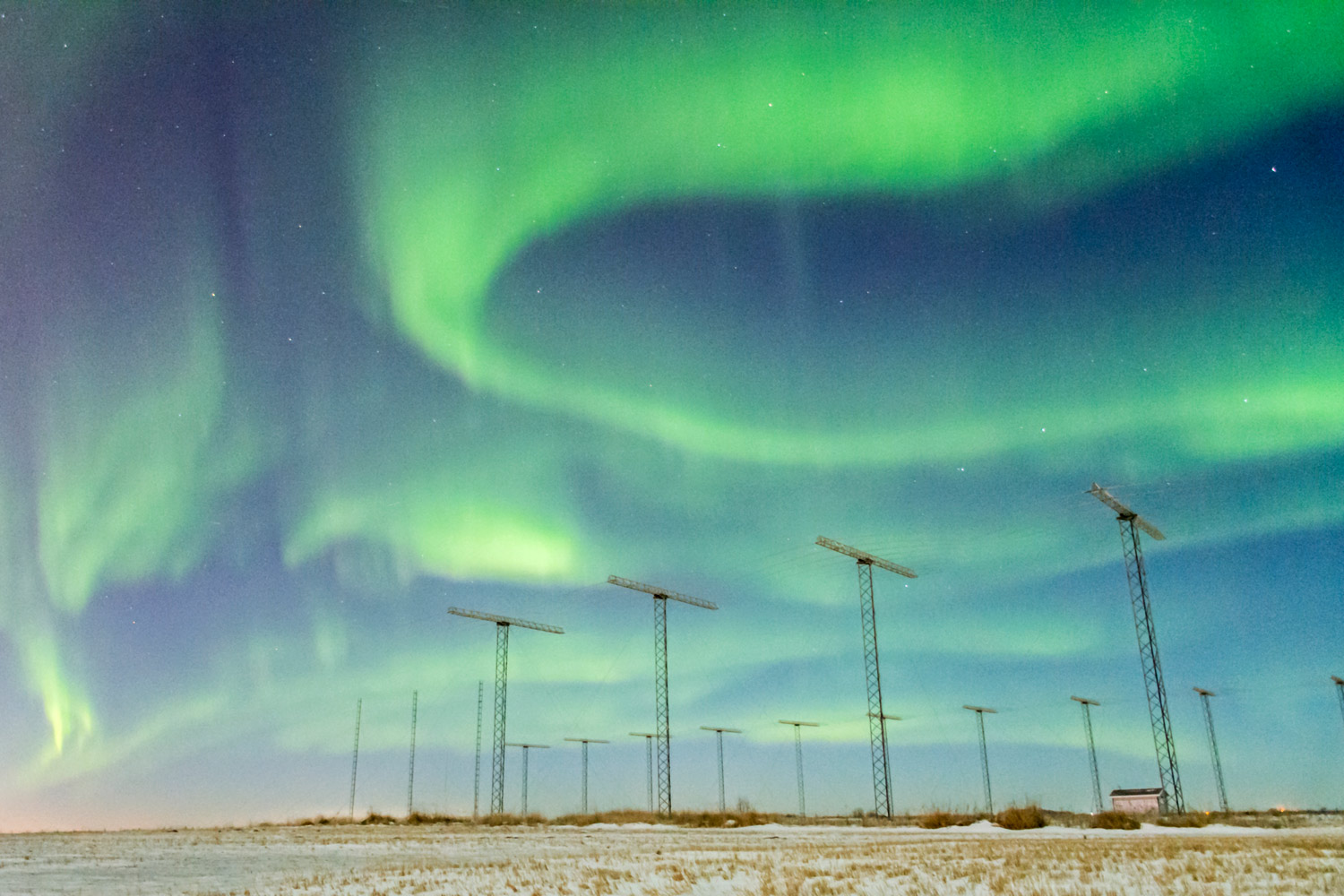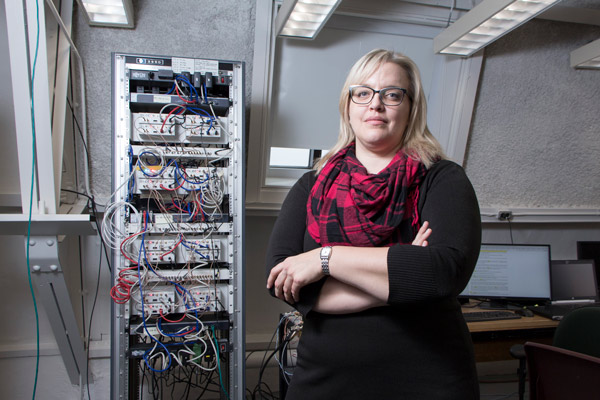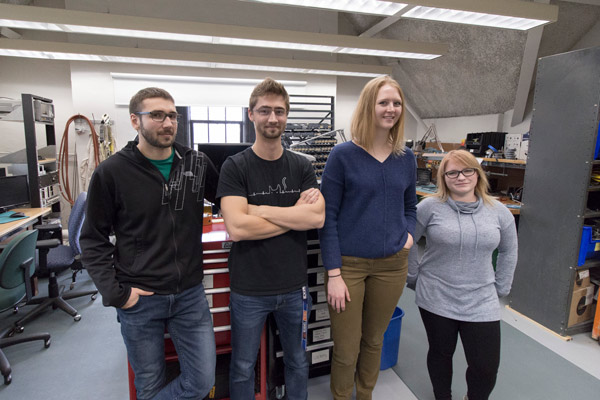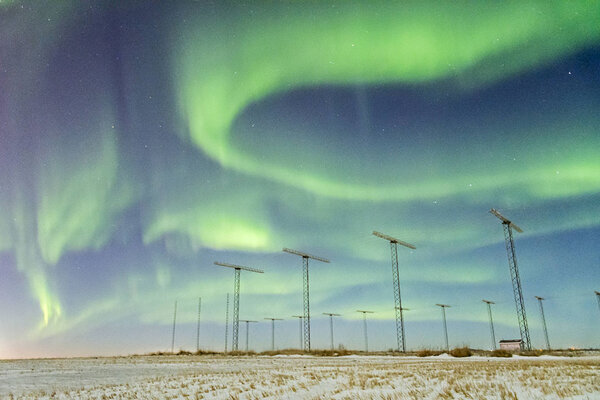
The space radar: 25 years of SuperDARN
The Saskatoon SuperDARN team likes to joke that some of its first radar transmitters were stolen by pirates. It's almost true.
By Chris Putnam
The Saskatoon SuperDARN team likes to joke that some of its first radar transmitters were stolen by pirates.
It’s almost true.
Twenty-five years ago, as the international SuperDARN collaboration was taking shape, the University of Saskatchewan team was tasked with building the transmitters for each country’s new radar sites. A batch of these was set on a ship bound for Iceland, where the French research team was building its radar.
“And so what happens? The engines quit on the ship. It’s just floating with no power,” recalls George Sofko, professor emeritus of physics and engineering physics in the U of S College of Arts and Science.
The ship was boarded by salvagers (something closer to rescuers than pirates, but we are free to picture them with parrots and peg-legs) and its cargo was saved.
There was one catch. Under maritime law, the salvagers of a ship are entitled to a portion of its value.
“I think the French talked them into the fact that we were poor university people with no big budgets … and it would be nice if they would not charge too much,” says Sofko. “So they came to an amicable agreement on this, and eventually the French got their transmitters.”
It wasn’t the only misfortune to afflict the early days of SuperDARN. In the summer of 1993, the brand new Saskatoon radar site was fully assembled and had undergone its first successful tests.
But then: “There was a terrific lightning storm, and it hit our antenna array,” remembers Sofko.
It took two months to replace the fried electronics and to lightning-proof the array. The system was up and running by late September, making this fall the official 25th anniversary of SuperDARN Canada.
Despite the early glitches, the project has proven over the last two-and-a-half decades to be a hugely successful global scientific collaboration—one in which the U of S has played an indispensable role.
Building something big
Sofko retired six years ago, but he still comes to campus almost every day to continue his research. The white-haired professor emeritus is bursting with enthusiasm about his work and about SuperDARN, one of his greatest scientific success stories.

“He is what you think of when you think of a scientist,” says physics professor Kathryn McWilliams, who took over from Sofko as principal investigator of SuperDARN Canada in 2012. “He is a really great mentor.”
The Saskatoon SuperDARN installation is a cluster of 20 massive radar antennas in a field just east of the city. Built to study activity in Earth’s upper atmosphere, it was one of the first such sites in a network that now includes 36 locations around the world and contributions by 11 countries.
The site came online in 1993, but for Sofko, the story begins much earlier than that.
SuperDARN arose out of radar experiments in the 1970s and 80s with names such as STARE (the Scandinavian Twin Auroral Radar Experiment) and DARN (the Dual Auroral Radar Network).
When the American/French DARN project was looking to expand, the U of S was an obvious partner to approach. Professor Balfour Currie, founder of what is now called the Institute of Space and Atmospheric Studies (ISAS) at the U of S, had been one of the first in the world to demonstrate that a radar signal could be bounced off the northern lights. U of S radar research into the aurora continued during the following decades through the work of scientists such as Sofko and fellow physics professor James Koehler.
What set SuperDARN apart from previous experiments was its scale. To study a larger portion of Earth’s auroral zone than ever before, the project’s masterminds envisioned a “super” network of dual radar pairs—twin radar arrays with overlapping views of the sky.
Saskatoon and its twin radar in Kapuskasing, ON were to be the second of these pairs. ISAS at the U of S became the headquarters of the Canadian portion of the project.
As principal investigator, Sofko hired a team of undergraduate students in 1992 to assemble the antennas at the Saskatoon site. One of these was McWilliams, who would go on to be one of Sofko’s graduate students and eventually his successor as leader of SuperDARN Canada.
When the Saskatoon radar switched on, DARN became SuperDARN; scientists had a new view of a massive swath of sky reaching north of Saskatoon into the polar cap.
Saskatoon took on a leadership role in the development and testing of SuperDARN technology because, unlike the other radar sites that were in remote locations or far from their home universities, Saskatoon’s was just down the road.
“We had a great engineering team 10 minutes away from our radar,” says Sofko. “When anything needed to be tested, and then if anything went wrong, we’d bring it back here to the lab, fix it up and take it out there. Nobody had that kind of access to their radars.”

Saskatoon also became the international data centre for SuperDARN: the site where information from all SuperDARN radars around the world is sent to be compiled into one master dataset.
The project picked up speed in the following years. As home ofthe Canadian SuperDARN headquarters, the U of S attracted top new researchers such as Jean-Pierre St. Maurice, the Canada Research Chair in Environmental Sciences. New countries joined the partnership and new radars were built, including three “PolarDARN” sites operated by the U of S in the Far North.
“You could see this thing just growing by leaps and bounds,” says Sofko.
The SuperDARN partners had taken on an important job, because events in Earth’s upper atmosphere can have consequences closer to home.
More than a light show
In September of 1859, people around the world were engrossed by an unusually intense display of the northern and southern lights. The aurora could be seen almost as far as the equator and glowed as bright as dawn at higher latitudes. Telegraph equipment was reported to sizzle, spark and start on fire.
Dubbed the Carrington Event, it was the most powerful example ever recorded of a magnetic storm—a major disturbance of Earth’s upper atmosphere caused by solar activity.
“If that hit today, it would have a much bigger impact because we rely so much more on technology,” says McWilliams.
Gigawatts of power are generated above our heads during a magnetic storm. That energy can damage satellites, disrupt wireless communications and take whole power grids offline.

Even mild disturbances in space have real impacts. Astronauts aboard the International Space Station and passengers on flights through polar regions get increased doses of radiation during periods of high solar activity. Oil and gas pipelines corrode more quickly, increasing the chances of a leak.
Canada received a taste of the danger above us in 1989, when a magnetic storm knocked out Hydro-Quebec’s power grid and caused a nine-hour blackout for six million people.
That storm did not compare to the power of the Carrington Event, but a future one might. A 2013 report by the U.S. government estimated that the damage to that country’s power grid from a Carrington-level “super storm” would be measured in trillions of dollars and might take up to a decade to fully repair.
It would be good, obviously, to be able to predict such events.
“You can take preventative measures once you understand what’s going to be coming your way,” says McWilliams. “You can build infrastructure that is robust enough to handle it. You can divert your polar flights to protect your crew and passengers. You can build a pipeline in a way that doesn’t suffer corrosion so much. But the problem is that we don’t understand the system well enough to predict it.”
Space weather
The Canada Foundation for Innovation (CFI) has identified SuperDARN Canada as a Major Science Initiative: one of a short list of national research facilities “for which the loss or absence of support would represent a serious setback for Canada.” Other government agencies—the Canadian Space Agency, the Natural Sciences and Engineering Research Council (NSERC) and Innovation Saskatchewan—have also made it a funding priority.
What makes SuperDARN so important? Put simply, it is one of the most effective and economical tools in the solar system for studying space weather.
“What we’re trying to understand is how the solar wind interacts with the Earth’s atmosphere through the magnetic field,” explains McWilliams.
The term space weather can seem odd at first glance. Space is famously empty; one might assume it has no business having weather.
But weather is a fitting description for the phenomenathat occur at the upper reaches of Earth’s atmosphere, beyond the boundary marking what we call outer space. Thousands of kilometers above us, the solar wind—a stream of charged particles ejected from the sun—interacts with Earth’s magnetic field and with a soup of plasma that surrounds the planet.
These interactions are responsible for the aurora, which occurs when charged particles “rain” down from space and light up the atmosphere. The brightest auroral displays happen during magnetic storms.
Particles at the edge of space flow in patterns not unlike weather patterns near the surface, driven by voltage systems rather than the pressure systems we are familiar with from the nightly weather forecast.

SuperDARN measures the movement of charged particles in the same way that police detect speeding vehicles. By bouncing a radar signal off the upper atmosphere and measuring the change in the returning signal, researchers can detect how fast the particles are moving. Knowing the speed of the particles tells them the surrounding electrical conditions, and combining the data from all three dozen SuperDARN radar sites around the world gives scientists a global picture.
Every minute of every day, SuperDARN tracks the changing space weather conditions above us.
25 years closer
The ultimate goal of SuperDARN and the space weather research community is to produce a working model that will allow reliable forecasts of space weather and its effects on Earth.
We’re not there yet, says McWilliams. “We’re still in the discovery phase where we’re trying to understand this huge and complicated process all the way from the sun to the surface of the Earth.”
SuperDARN has brought scientists much closer to that goal. Our understanding of how and why plasma circulates around the globe “has improved dramatically because of SuperDARN,” says McWilliams. The system has also provided fine detail about the small-scale physics that drive the larger patterns.
Researchers now have a good grasp on most of the natural factors that contribute to space weather. The next step will be bringing it all together, with 25 years of SuperDARN data to help light the way.


